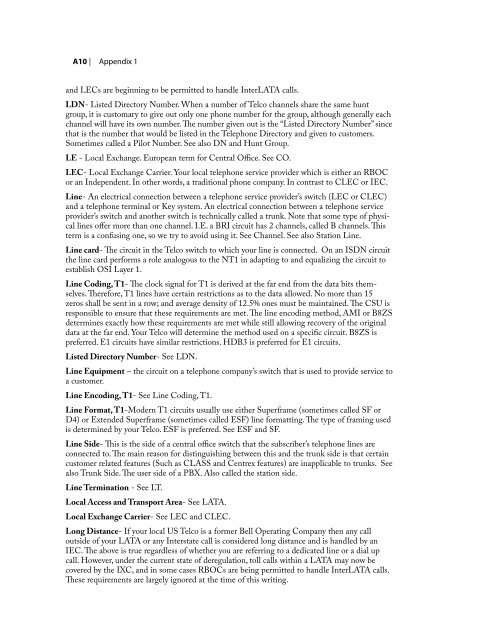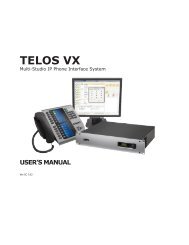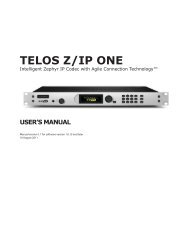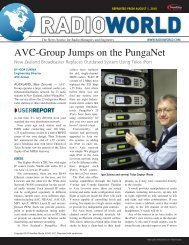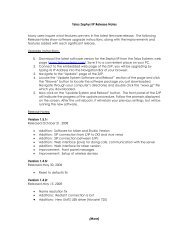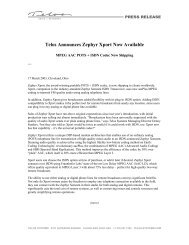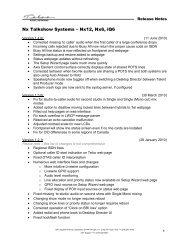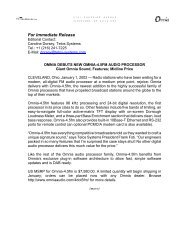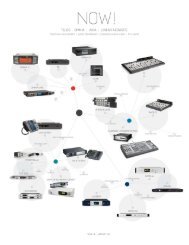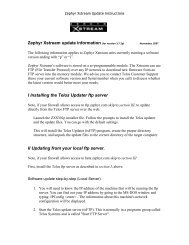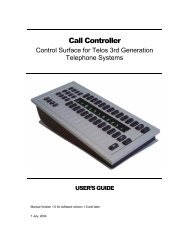Hx1-Hx2 Manual-1.4.1 - Telos
Hx1-Hx2 Manual-1.4.1 - Telos
Hx1-Hx2 Manual-1.4.1 - Telos
You also want an ePaper? Increase the reach of your titles
YUMPU automatically turns print PDFs into web optimized ePapers that Google loves.
A10 | appendix 1<br />
and LECs are beginning to be permitted to handle InterLATA calls.<br />
LDN- Listed Directory Number. When a number of Telco channels share the same hunt<br />
group, it is customary to give out only one phone number for the group, although generally each<br />
channel will have its own number. The number given out is the “Listed Directory Number” since<br />
that is the number that would be listed in the Telephone Directory and given to customers.<br />
Sometimes called a Pilot Number. See also DN and Hunt Group.<br />
LE - Local Exchange. European term for Central Office. See CO.<br />
LEC- Local Exchange Carrier. Your local telephone service provider which is either an RBOC<br />
or an Independent. In other words, a traditional phone company. In contrast to CLEC or IEC.<br />
Line- An electrical connection between a telephone service provider’s switch (LEC or CLEC)<br />
and a telephone terminal or Key system. An electrical connection between a telephone service<br />
provider’s switch and another switch is technically called a trunk. Note that some type of physical<br />
lines offer more than one channel. I.E. a BRI circuit has 2 channels, called B channels. This<br />
term is a confusing one, so we try to avoid using it. See Channel. See also Station Line.<br />
Line card- The circuit in the Telco switch to which your line is connected. On an ISDN circuit<br />
the line card performs a role analogous to the NT1 in adapting to and equalizing the circuit to<br />
establish OSI Layer 1.<br />
Line Coding, T1- The clock signal for T1 is derived at the far end from the data bits themselves.<br />
Therefore, T1 lines have certain restrictions as to the data allowed. No more than 15<br />
zeros shall be sent in a row; and average density of 12.5% ones must be maintained. The CSU is<br />
responsible to ensure that these requirements are met. The line encoding method, AMI or B8ZS<br />
determines exactly how these requirements are met while still allowing recovery of the original<br />
data at the far end. Your Telco will determine the method used on a specific circuit. B8ZS is<br />
preferred. E1 circuits have similar restrictions. HDB3 is preferred for E1 circuits.<br />
Listed Directory Number- See LDN.<br />
Line Equipment – the circuit on a telephone company’s switch that is used to provide service to<br />
a customer.<br />
Line Encoding, T1- See Line Coding, T1.<br />
Line Format, T1-Modern T1 circuits usually use either Superframe (sometimes called SF or<br />
D4) or Extended Superframe (sometimes called ESF) line formatting. The type of framing used<br />
is determined by your Telco. ESF is preferred. See ESF and SF.<br />
Line Side- This is the side of a central office switch that the subscriber’s telephone lines are<br />
connected to. The main reason for distinguishing between this and the trunk side is that certain<br />
customer related features (Such as CLASS and Centrex features) are inapplicable to trunks. See<br />
also Trunk Side. The user side of a PBX. Also called the station side.<br />
Line Termination - See LT.<br />
Local Access and Transport Area- See LATA.<br />
Local Exchange Carrier- See LEC and CLEC.<br />
Long Distance- If your local US Telco is a former Bell Operating Company then any call<br />
outside of your LATA or any Interstate call is considered long distance and is handled by an<br />
IEC. The above is true regardless of whether you are referring to a dedicated line or a dial up<br />
call. However, under the current state of deregulation, toll calls within a LATA may now be<br />
covered by the IXC, and in some cases RBOCs are being permitted to handle InterLATA calls.<br />
These requirements are largely ignored at the time of this writing.


